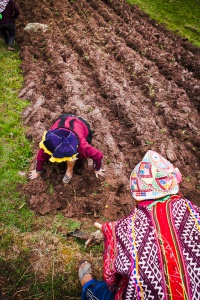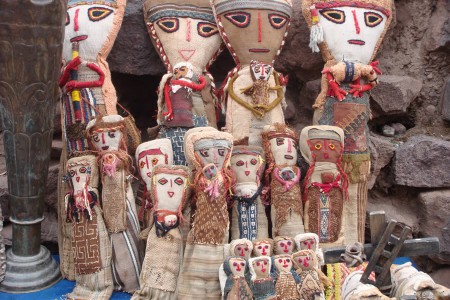
Esta página también está disponible en:
 Español
Español
The Sacred Valley of the Incas is a stunning and historic valley that was inhabited by the Runas, human beings in Quechua, of the *Tahuantinsuyo (Incan nation) who built impressive works of agricultural engineering admired by all of humanity. Situated within easy reach of Cusco, the Sacred Valley of the Incas is a spectacular valley, located within the South American Andes mountain range. Running parallel to the winding Urubamba River, which also goes by the name of the Vilcanota River or the Wilcamayu River, the Sacred Valley of the Incas is just 15 km / 9 miles to the north of Cusco.
This beautiful valley between the towns of Pisac and Ollantaytambo was greatly admired by Peruvian ancestors due to the special conditions found here, such as a beneficial climate, fertile lands and the presence of the Wilkamayu River (the Sacred river in Quechua). The Runas, with the incentive provided by the qualities granted by nature, built architectural constructions related to agriculture, which was ancient Peru’s main activity. In this area, the Incas found the perfect place to leave proof of their intrinsic knowledge of hydraulic engineering and their deep love of nature. This is why aqueducts, irrigation canals, channels of the Wilkamayu River, impressive terracing and centers for scientific astronomic observation and spiritual activities still stand today. The Sacred Valley remains a lush agricultural region supplying the city of Cusco with much of its produce such as maize, fruit and vegetables.
FROM PISAC TO OLLANTAYTAMBO
From Pisac, following the Wilkamayu River towards the west on the narrow flat and windy paved road between the river and the hills, pass through the towns of Calca, Yucay and Urubamba before arriving at Ollantaytambo, with several lovely small towns dotted along the way.
PISAC
This picturesque town with a blend of mestizo and colonial architecture with cobblestone streets belongs to the province of Calca at the entrance to the Sacred Valley of the Incas, 32Km / 21 miles down a modern highway from the city of Cusco. The scenic drive from Cusco offers spectacular welcoming views to the Sacred Valley, with the majestic Apu Linly mountain and the mesmerizing Incan terraces that together with the play of light and shade and the flowering of crops form a condor. In the spacious Plaza de Armas was an impressive pre Columbian Pisonay tree that fell in 2014. Pisac has both Western and native features that make it an original and typical town of the region, with the presence of the thirteen traditional highland communities that are part of Pisac, and the foundation of Inca terraces and irrigation channels that gracefully run along Pisac’s cornfields.
The main attractions at Pisac include the famous Traditional Market and the Archeological Site with extensive agricultural terracing and more.
PISAC ARTS AND CRAFTS MARKET
The colorful Pisac market offers all sorts of handcrafts featuring textiles, jewelry and ceramic goods. Textiles are not to missed, and you should look for the traditional women from the highland communities above Pisac who offer their own pieces, which are one of a kind weavings using all natural plants. Weavings from Amaru and Chaihuatiri are especially fine and world renowned, worthy as collectors items. There are also ponchos, sweaters and bags. The ceramic plates, ashtrays, tea sets, and chess sets are hand painted by Pisenos using the traditional geometric Inca design. You can also find replicas of pre-Columbian pottery. The handcraft fair is now held everyday on the main square of Pisac. Sunday is the most festive market day as people from the highland native communities come in their best traditional dress to sell or trade their products. It is fun to explore the typical food section of the market on Sundays, where you will find all types of native Andean potatoes, and exotic fruit brought from the nearby rainforest.
PISAC ARCHAEOLOGICAL COMPLEX
In the upper part there are the remains of this pre-Columbian settlement located a few kilometers from the mestizo town. It takes up an entire mountain made up of different neighborhoods or squares, the main one being Intiwatana, which is admired for the architectural skill with which its constructions were built. At the same time, the pre-Columbian cemetery is also of great interest as it is the largest found in this part of the continent. There are thousands of tombs, sadly many of which have been looted. The complex is also famous for the colossal terraces that circle the mountains.
CALCA
Calca is 20 km / 12 miles, a twenty minute drive from Pisac passing through the smaller towns of Coya and Lamay. This area has a beautiful landscape, surrounded by the Pitusiray and Sawasiray snow-capped mountains. The archaeological complex of Huchuy Qosqo is located in this province, as well as the medicinal hot mineral baths of Machacancha (sulfurous hot water) and Minasmoqo (cold bubbling mineral water).
YUCAY
Yucay is approx. 4 km / 2.5 miles from Urubamba. It was an Incan center of agricultural production in the Sacred Valley because of its particularly mild climate, fertile land, abundant water and vegetation, especially fruit trees. You can see a construction made of stone and adobe mud brick with haute- and bas-relief decorations as you pass through the town on the main road near the central plaza area that has two beautiful Pisonay trees. Urubamba is not located far from here.
URUBAMBA
Located 78km from Cusco via Pisac and 57km via Chinchero, it is about a 45 minute drive from Pisac. Lying at the very junction of the Cusco valley road, Urubamba is an important transit hub, being a good base for those intending to visit Moray and Salinas. It is located in the heart of the Sacred Valley and is known as the “Pearl of the Vilcanota” with beautiful countryside’s and a healthy climate, located at the foot of the majestic snow-capped peak Chicon. Like many places along the valley Urubamba is in a fine setting with snow-capped peaks in view. The nearby White Mountain range provides the area with scenery of extraordinary beauty.
OLLANTAYTAMBO

Ollantaytambo is 58 km from Pisac, and is about an hour drive through the Sacred Valley. It is 2,700 metres (8,856 feet), and is pronounced ‘oy-yahn-tie-tahm-bo’ but everyone calls it ‘Ollanta’ for short. Ollanta is the starting point for the Inca Trail. From here the only way of getting to Machu Picchu is on foot or by train. The town is the best surviving example of Inca city planning, with a maze of cobblestone streets and irrigation channels. One can see the architectural style of its streets and squares which are distinctly pre-Columbian, with enormous polyhedrons forming the walls and trapezoidal doors. The urban distribution was set along rectilinear and narrow streets, which have been inhabited constantly by natives since ancient time, and is in the shape of a corncob. In the upper and western part of the city rises a mountain, which houses innumerable pre-Columbian constructions such as magnificent temples and terraces. The archaeological complex is spectacular, and served as a gigantic agricultural, administrative, social and spiritual center in the era of Tahuantinsuyo. A striking construction is the partially destroyed main temple, where once can see the front stone carving made up of six perfectly built red monoliths. It also has stepped molds, a characteristic made by the Earth. This made academics consider Ollantaytambo a living museum. The Museo CATCCO is on hand and filled with local history.
TO MACHUPICCHU

The town of Ollantaytambo is located in the far western part of the Sacred Valley, in a place where the asphalt highway connects with the circuit called the Sacred Valley of the Incas and the railway that leaves Cusco bound for Machu Picchu. The train service covering the Cusco-Machu Picchu route allows tourists to visit the area, board the train in Ollantaytambo, and within two hours arrive in Aguas Calientes, from where buses leave for the Machu Picchu citadel. One can also get off at Ollantaytambo on the way back to Cusco from Machu Picchu, and begin to explore the Sacred Valley of the Incas from there.
CHINCHERO
Widely thought to be the birthplace of the rainbow by many Incas, Chinchero is a traditional Andean village, around 400 meters or 1,310 feet higher than Cusco and a particular highlight of the Sacred Valley. Visitors to Chinchero can expect to find rich Inca ruins, magnificent mountain views, a fascinating archaeological museum, lively Sunday market, a massive Inca wall, and a popular trail leading to Wayllabamba. A former Inca agricultural center, this district of the province of Urubamba is made up of 10 “Ayllus” or indigenous communities. Located at 3,762 mete above sea level, Chinchero is 28 km down a modem highway from the Cusco tourist circuit. It possesses a beautiful Andean landscape and is surrounded by the year-round snow-capped peaks of Chicon, Wequey Willca (commonly Calle Puma Sillo or Veronica).
SALINAS – Roughly 7 km or 4 miles from Urubamba and next to the village of Tarabamba, Salinas is where you will find literally thousands upon thousands of historical saltpans, which date back to Inca times.
MORAY – Sited some 10 km or 6 miles from Urubamba, Moray resembles something of an amphitheater, with breathtaking terracing creating two distinctive bowl shapes, one large and one small. It is believed that each terrace offered the Incas different climatic conditions for growing crops and remains something of a living museum.
GASTRONOMY
The Sacred Valley is the heart of ancient agrarian heritage, so naturally there are numerous delicious gastronomic specialties. Those that stand out are corn-based dishes such as corn-on-the-cob with fresh cheese, cream of corn soup, tamales and corn cake, as well as fried trout, fried pork “Chicharron” and stuffed chili peppers called “Rocoto”. There are also typical drinks such as Chicha de Jora (a fermented maize corn beer), Chicha Blanca that has no alcohol content and is typically made form quinoa, and from November to March, a drink based on wild strawberries called “Frutillada”.
FLORA AND FAUNA
The valley is mainly agricultural, where the finest corn in Peru is produced, one that is highly nutritious and of excellent quality. The area also produces varieties of potatoes, cereals, greens and fruits like apples, peaches, plums and strawberries as well as a variety of decorative plants. The fauna includes a great variety of animals such as deer, the vizcacha rodent similar to a rabbit, minks, skunks, foxes and pumas. There are also birds like doves, thrushes, goldfinches and hummingbirds. The Wilkamayu River is rich in salmon trout and rainbow fish. There are also domestic animals such as cattle, sheep, pigs, chickens, ducks, donkeys and horses.
*The word Tahuantinsuyo is derived from two quechua words: Tawa, meaning four, and suyo meaning state.
EXCURSIONS AND TRANSPORT
There are several travel agencies in Cusco that organize excursions and trips to the Sacred Valley of the Incas, and if only transport is needed, it is recommended to choose tourist level services for comfort, flexibility and safety. Pisac Inn offers exclusive excursions to hotel guests and can help arrange transportation. You can ask for information at the Front Desk.
*The word Tahuantinsuyo is derived from two quechua words: Tawa, meaning four, and suyo meaning state.
You can download the Sacred Valley Map in a PDF format by clicking here:
















Leave a Comment